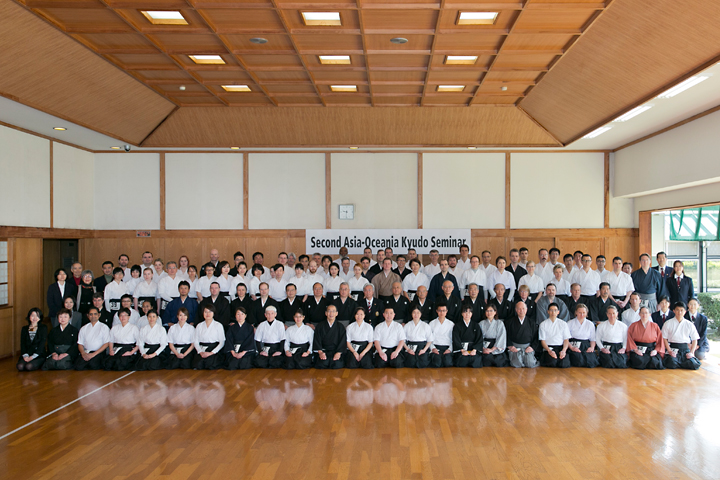
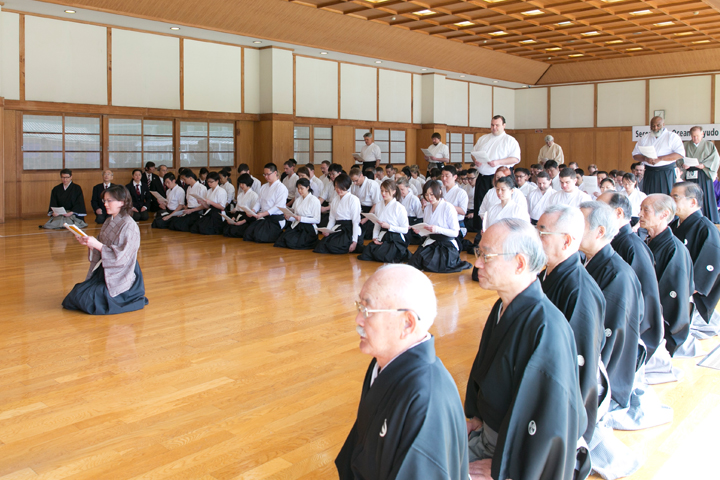
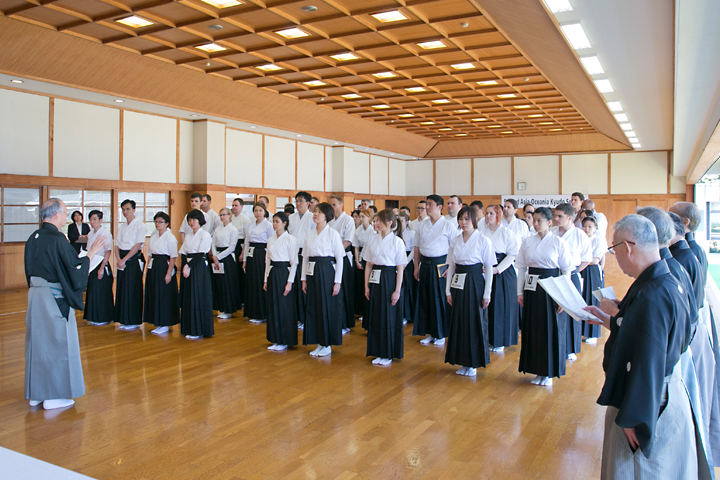
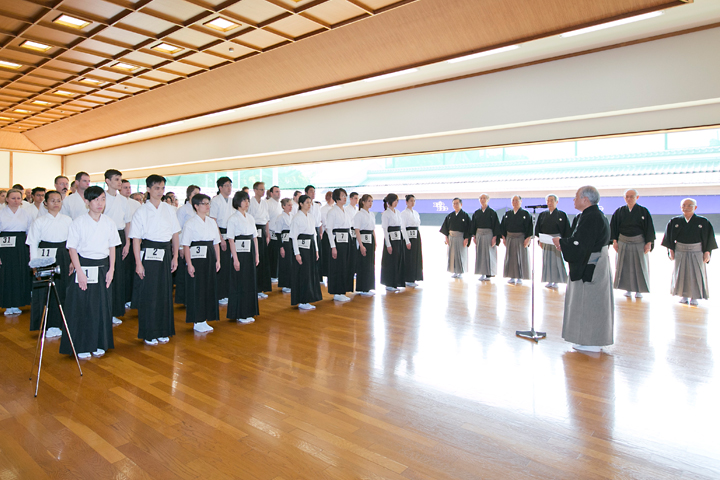
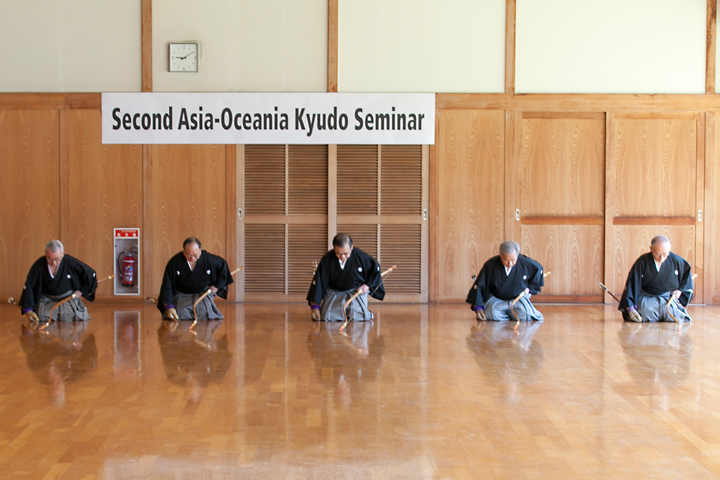
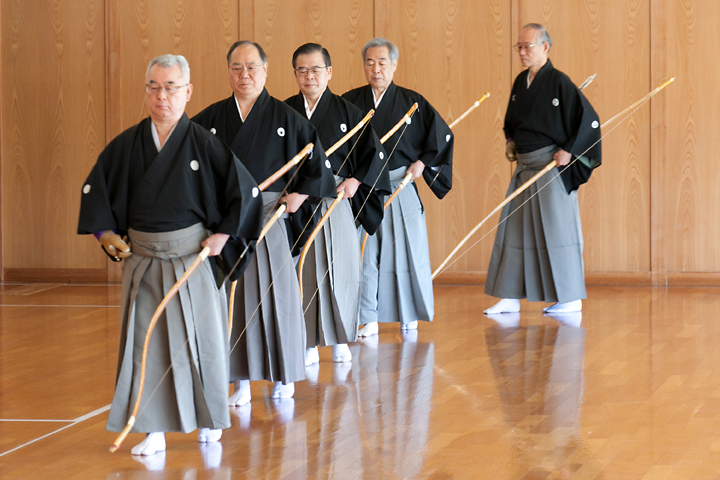
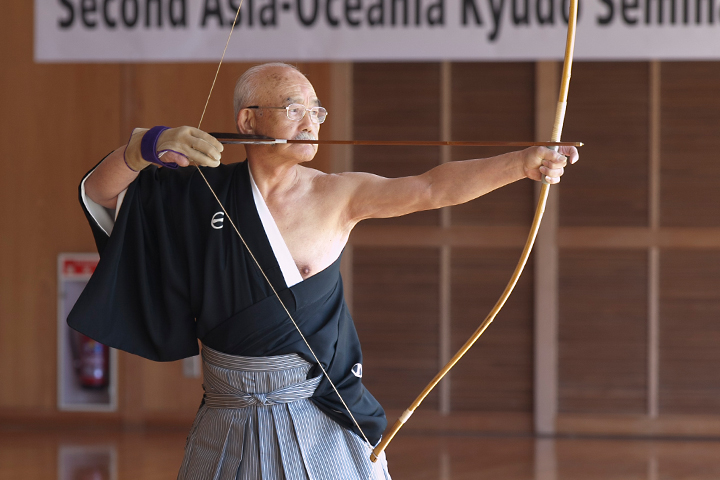
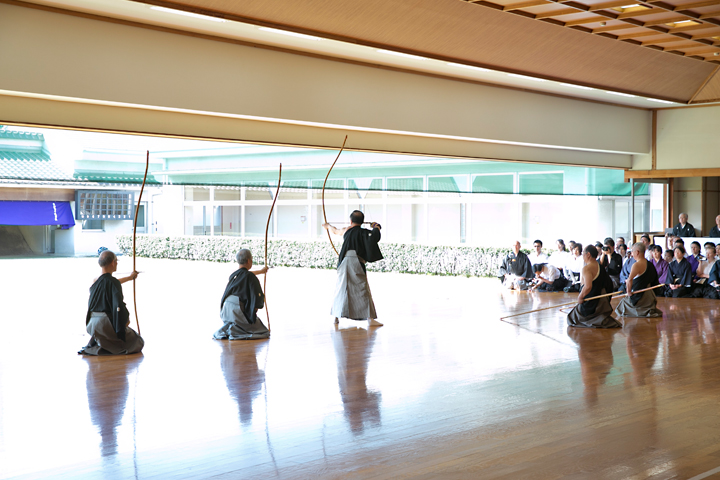
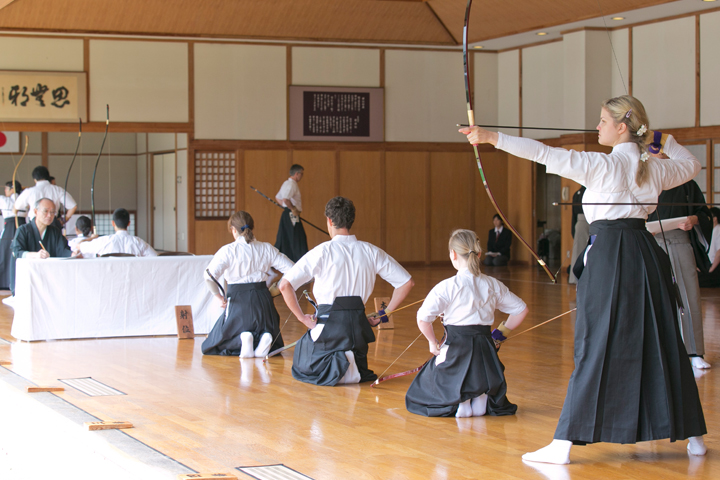
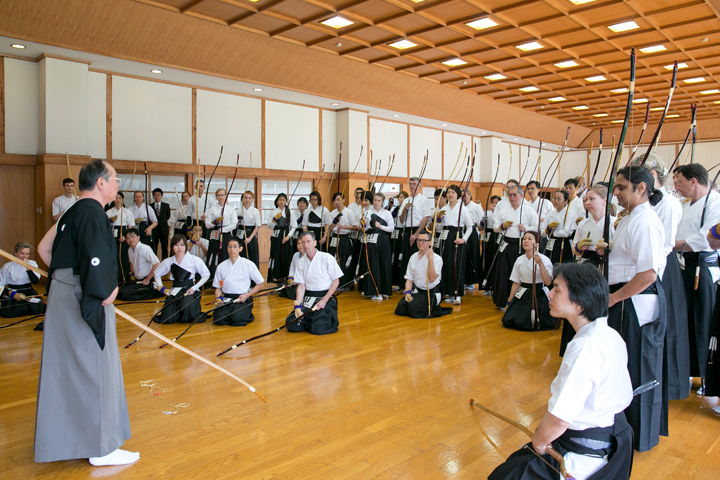
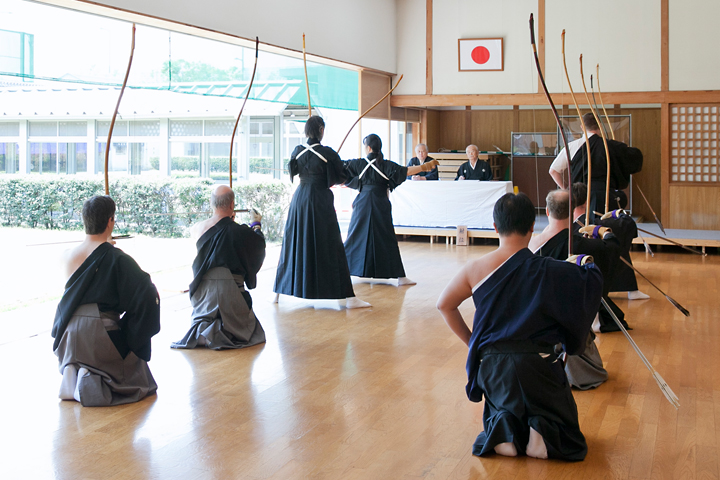
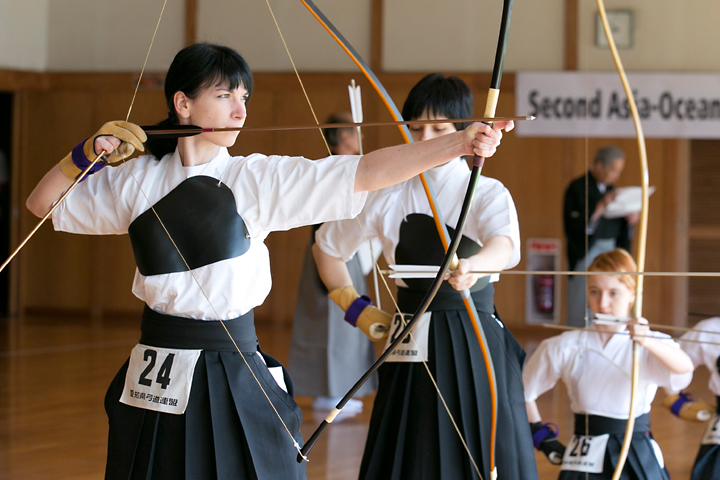
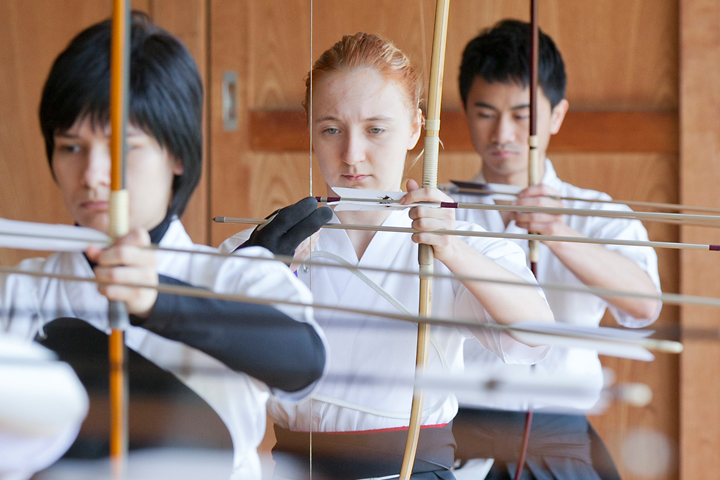
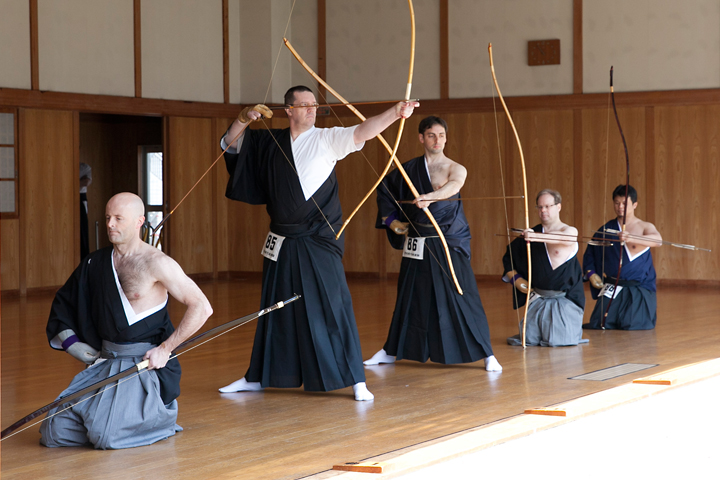
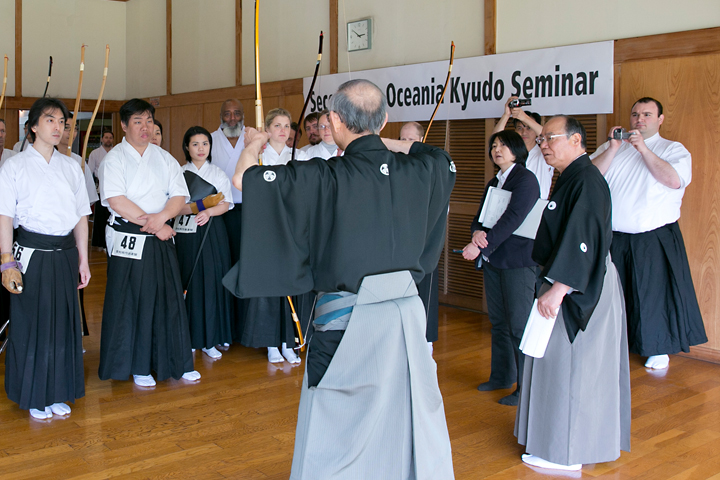
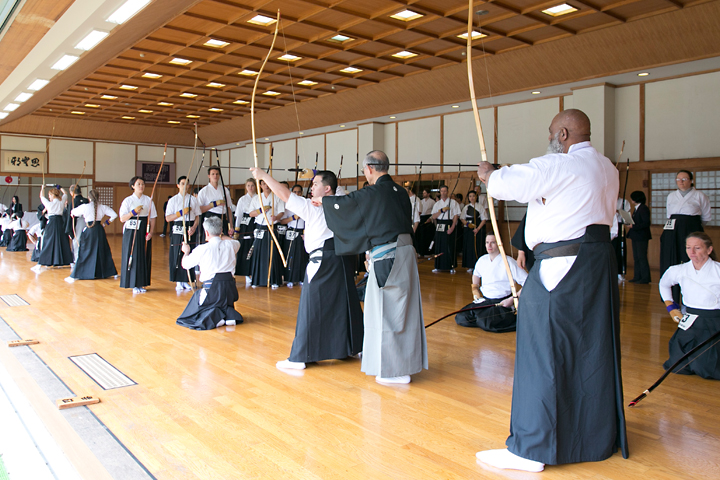
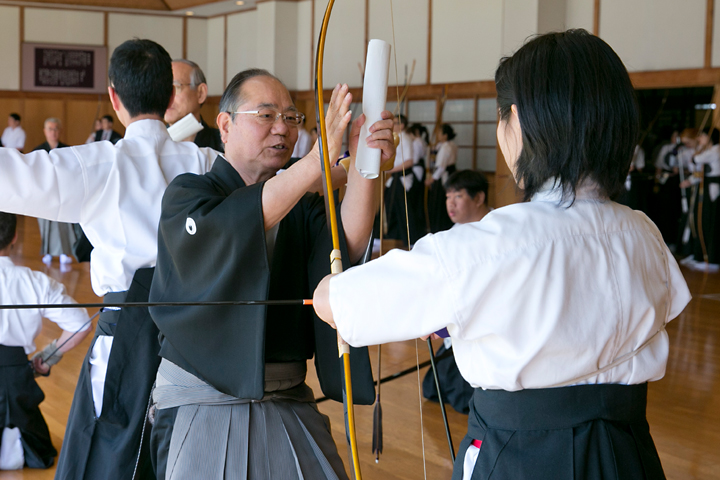
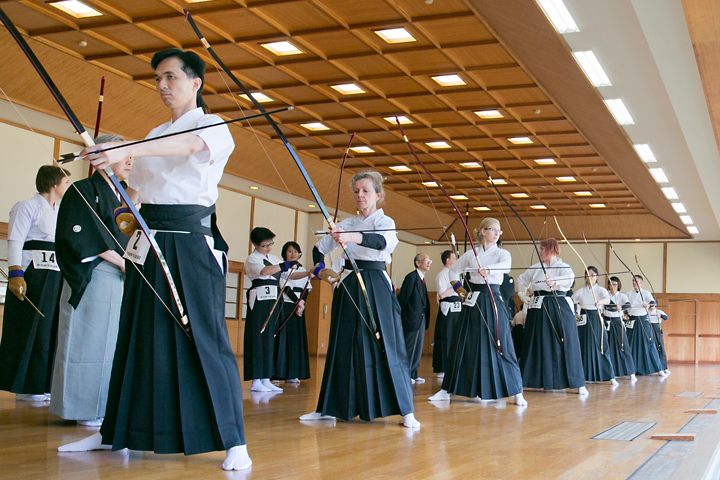
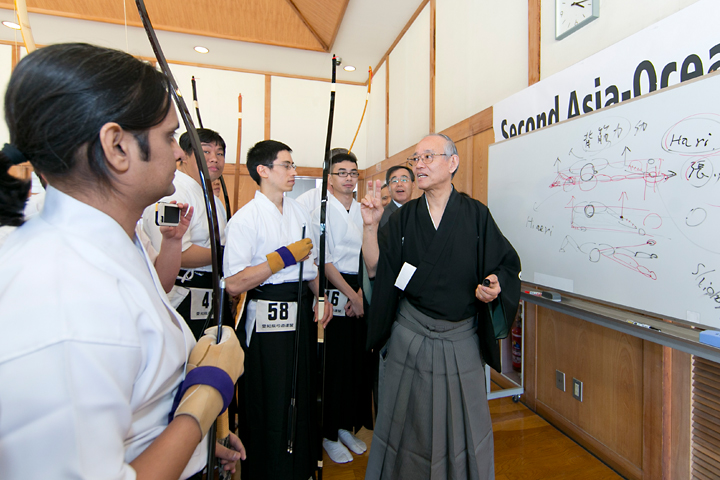
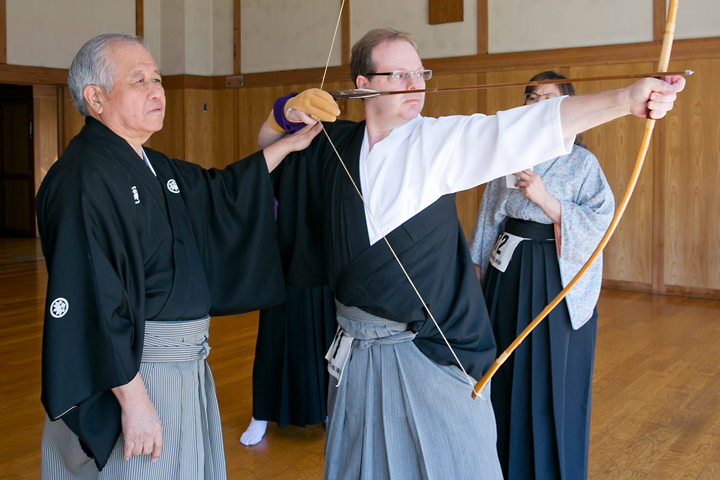
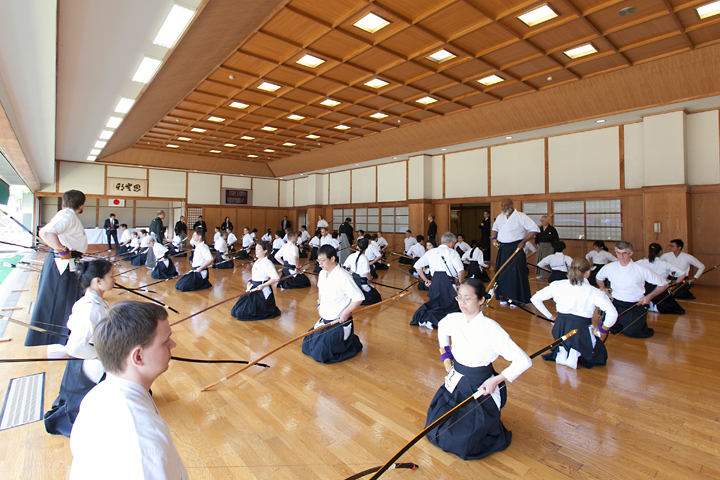
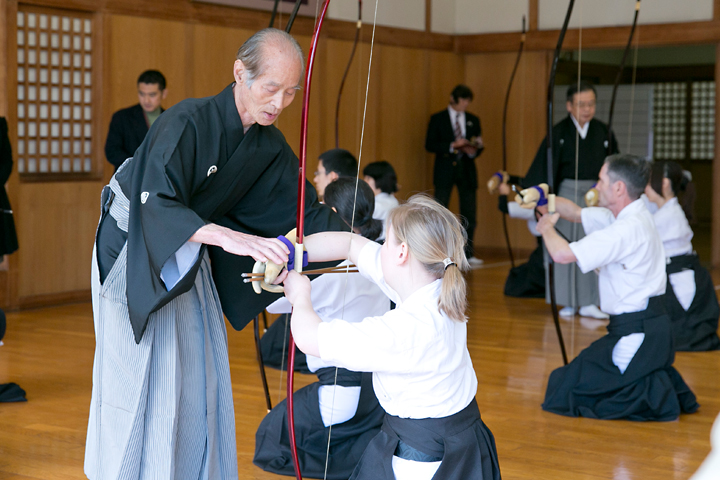
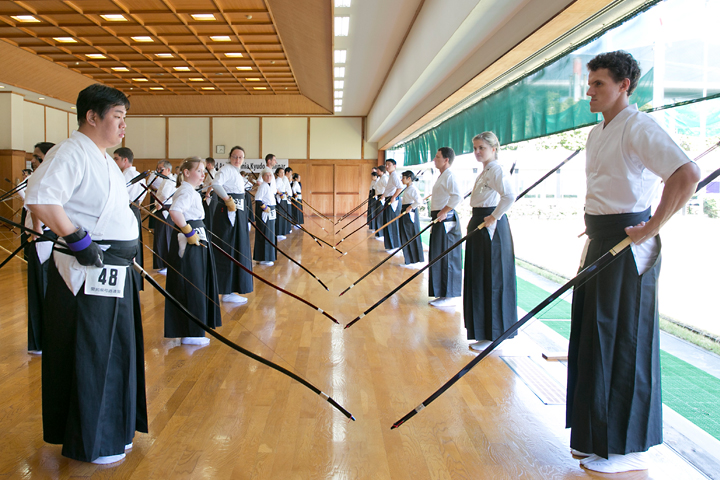
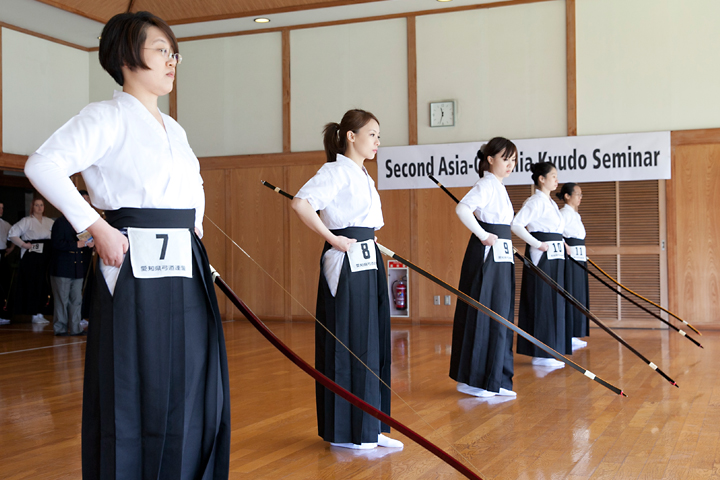
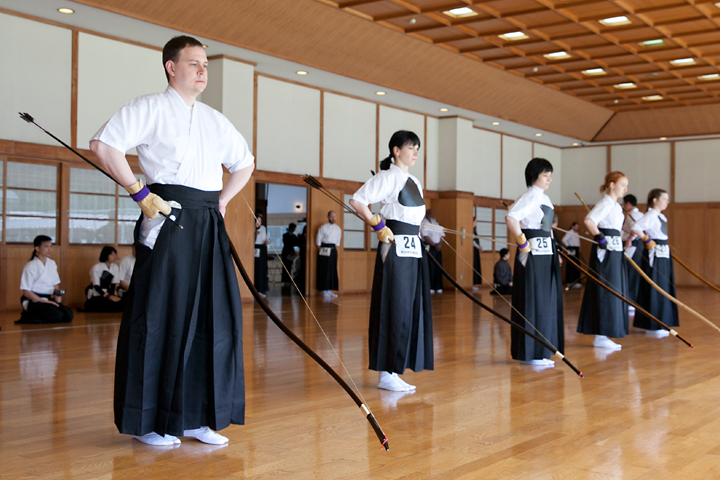
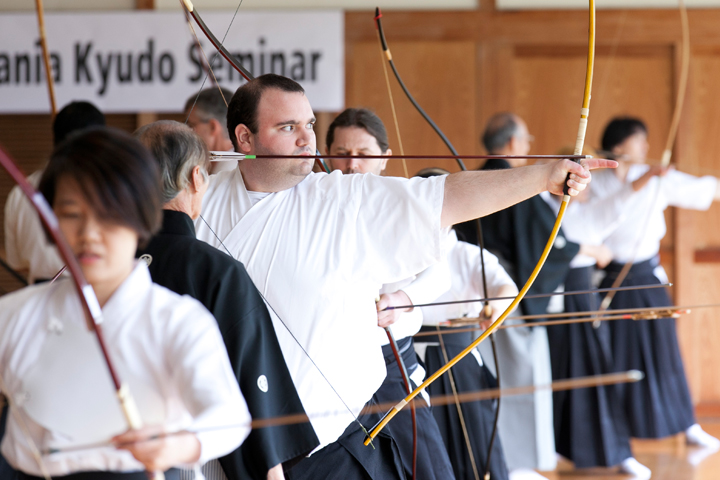
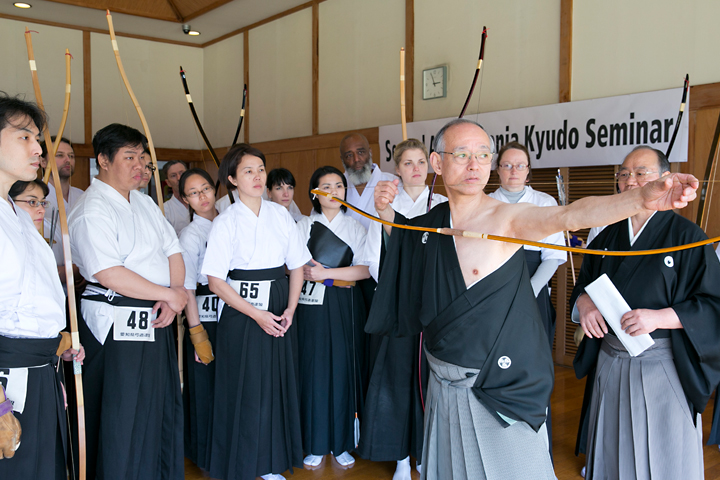
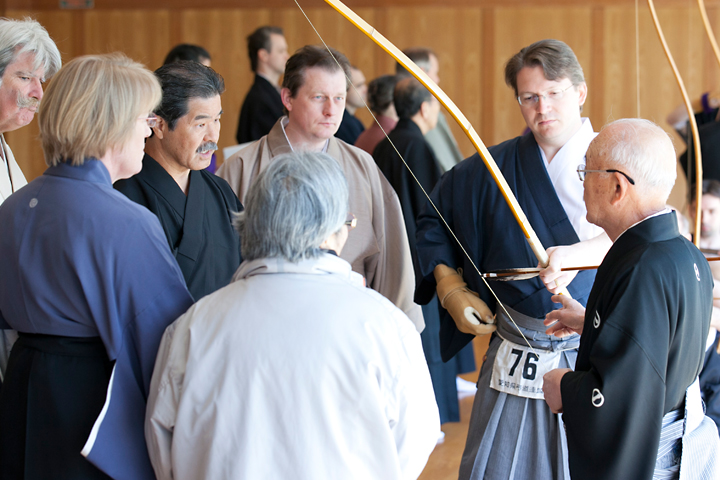
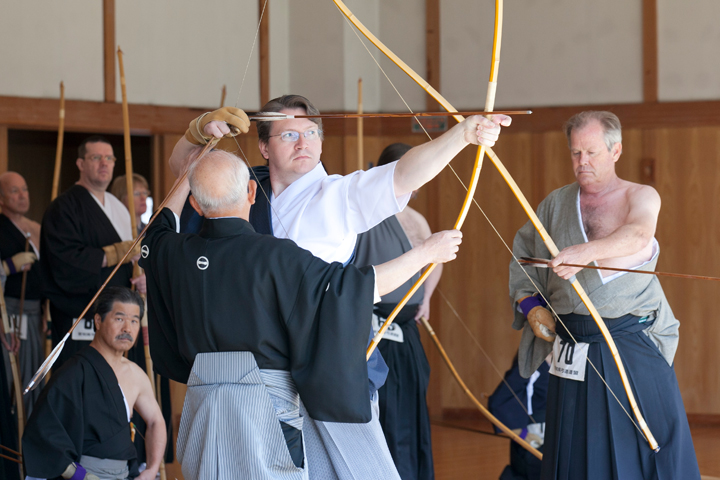
Seminar Report
「The Second Asia-Oceania Seminar
- With harmony and peace of mind; Kyudo ties together the people of the world.-」
Dates:April 12 ? April 14, 2013
Venue:Nihon Gaishi Sports Plaza Kyudojo (Nagoya, Aichi, Japan)
Sponsor:International Kyudo Federation / Co-sponsor: All Nippon Kyudo Federation
Around the same time last year, the cherry blossoms had already been in full bloom around the seminar venue, but this year the pedals had already fallen. At 8 am on the first day of the seminar, some attendants had already arrived waiting at the front door of the training hall and as it opened, the attendees began to trickle in.

Day 1
At 9:30am the Opening Ceremony was held with all participants lining up in order of their number waiting anxiously. Most were from the Asia Oceania region: Taiwan, Hong Kong, New Zealand and Australia. While others were from Russia, Canada, the USA and Europe along with foreign residents living in Japan; a total of 93 participants this time. The number of participants increased more than 30% over the First Asia Oceania Kyudo Seminar ranging from Mudan to Renshi 6-Dan; with Shodan forming the largest group.
The opening began with the President of the International Kyudo Federation, Takeo Ishikawa, making his welcome speech to the participants. (Please see excerpt below.) Next, Chief Instructor Ichiro Uozumi and the other instructors for the seminar were introduced. The line-up was enough to make even those training in Japan envious.
Tomio Kato, Renshi 5-Dan (USA) lead in the reciting of the Raiki-Shagi and Shaho-kun followed by a Yawatashi performance. Ichiro Uozumi, Hanshi 8-Dan performed Ite while Yoshimitsu Usami and Izuru Kato, Hanshi 8-Dan performed Kaizoe.
At 10:20 am, participants were divided into four groups and started off with Hitote-Gyosha (Shooting of two arrows). Group 1 consisted of Mudan members, Group 2 were 1-Dan members, Group 3 were 2-Dan and 3-Dan members , while Group 4 were 4-Dan and above and Renshi members. Groups 1 to 3 used the Kinteki Shajo (Short Distance) while Group 4 used the Enteki Shajo (Long Distance).
Everyone shot in groups of five and once everyone had finished, a lunch break was held. At 1:30 pm, Shagi (Shooting Techniques) instruction started. The Kinteki Shajo was divided into three Shajo spaces each having their own targets. Each group were further divided into groups of three practicing entering the dojo and facing the mato. Each group had by two instructors watching carefully while each individual was given careful instructions.
Many of those who were not shooting yet waited outside the Shajo, or watched from a distance inside the Shajo while the instructions watching those shooting. "If you are not shooting next, then feel free to get close to those shooting and watch what type of instructions are being given" said one of the instructors.
After giving shooting instructions for an hour and a half, it was time for a break. While the instructors had gone to take a rest, many participants decided to stay in the Shajo and continued their shooting practicing. While it seemed they might slow down after so much practice; they seemed to be full of energy again.
After the break, it was time to practice the Kihontai (fundamental form).
Group 1 to 3 practiced together watching the instructors demonstrate the proper movements of Standing, Sitting Down, Hiraki-ashi (turning while kneeling) and Toriyumi posture (holding of the yumi and ya) and Yatsugae movement (Nocking of the arrow). Students would then attempt the same movements while the instructors corrected them strictly.
Afterwards, the instructors explained how to handle a Shitsu feeling that it is not taught as often overseas. There are three basic principles: the first is to handle your error promptly, the second is to act accordingly with Rei, and the third is to express your apology for the error. Instructors asked the students if there were any questions with some raising their hands. Instructors answered several question, but stated "The best way to handle a Shitsu is to avoid it in the first place."
At 5 pm, the first day of the seminar came to an end. In the evening, all participants gathered for a reception party at the Nihon Gaishi Forum. All members were called up to stage by country to make self-introductions. It was a good opportunity to get to know each other better.

Day 2
Chief Instuctor Uozumi finishing the Hairei mentioned in his morning greeting "in order for us not to be in pain with the muscles that we use, it is important to do proper stretching. At the end of day, I will show you how."
Junko Kurita, 5-Dan (USA) led the recital of the Raiki-Shagi and Shaho-kun. Next, the instructors gave a special performance, Mochimato-Sharei. Ite consisted of Yoshimitsu Usami, Masakazu Honda, Izuru Kato, Hanshi 8-Dan, Mikio Enomoto and Minoru Kawanishi, Kyoshi 7-Dan.
Participants were allowed to take photos and videos with some eagerly sitting in the front to capture the special performance.
Afterwards the whole day was spent on Shagi instruction. In the morning at the Kinteki Shajo, it was divided into three shajo spaces again each with three targets for a total of nine. In the afternoon, it was divided into six shajo spaces with two targets each. This allowed everyone to get as much shooting practice as possible while receiving detailed instructions. Some participants at certain times were being sandwiched by two instructors at the same time with one checking his front side and the other his back side.
Because of the different national background of the participants, there was of course a need to address the different languages needed. The supervisors of the seminar, the Aichi Prefecture Kyudo Federation, received assistance from local volunteer centers helping with the translations for English, Chinese, Russian and German. When instructors had a lot of advice to give, the interpreters were busy trying to relaying what was said. Sometimes not much was spoken by the instructors and to properly translate what was said was often time not easy. Nonetheless the interpreters worked diligently and translated as best as they could.
At 5pm, Shagi instruction end and as Chief Instructor Uozumi in the morning, he showed everyone how to cool down by doing some muscle stretches finishing the second day of the seminar.
Day 3
Ikuko Komei, 4-Dan (Switzerland) led the recital of the Raiki Shagi and Shaho-kun.
Many of the participants would have be taking the Shinsa examination the next day, so the primary instructions for the day were mainly for its preparation.
Instructors then broke everyone into groups of five. "The group you are in will be the same as the one during Shinsa, so please put effort into during good teamwork," as one of the instructors emphasized. As a group entered the Shajo, walking towards to Honza and then reaching Shai, instructors would clap their hands to demonstrate the pacing. After shooting and heading towards the exit, instructors gave lots of advice on the timing. For beginners, the tempo of walking and Maai for each action were carefully instructed. For 4-Dan and above, it was more strict with the students being warned "that poor action will result in point deduction, so please be careful."
Before noon, all lessons had finished and a closing ceremony was held. Sascha Weiss, Renshi 6-Dan (Germany) representing all the participants was given a Certificate of Completion. Chief Instructor Uozumi made the closing speech by saying "the training of Kyudo has its mountains and valleys. You will run into many walls and the path that we walk is not flat. However, perseverance is our power to overcome. Never give up and always do your best. I am very happy as a member of the International Kyudo Federation that Kyudo has become more popular in the Asia Oceania region. I hope that everyone's understanding of Japanese Kyudo becomes deeper and 'with harmony and peace of mind, Kyudo ties the people of the world.' With this motto, we hope to continue the healthy development of the International Kyudo Federation."
The Second Asia Oceania Kyudo Seminar came to a close. The afternoon was spent on preparation for the Shinsa examination. Chief Instructor Uozumi said "I am pleased to see that everyone was able to demonstrate a higher degree of skill than expected" when the seminar was complete.


Today, as a continuation from last year, more participants have gathered here for the Second Asia Oceania Kyudo Seminar and as the host of the event, I am extremely happy to see such growth.
There are already many Kyudo practitioners active in the USA and Europe but since the creation of the International Kyudo Federation, there has been an increase of those interested in Kyudo in the Asia Oceania region. Through the efforts of many involved, we have the opportunity to hold a seminar for this region. We believe that this is an integral part of promoting and developing Kyudo internationally.
I hope to see more practitioners partake in this seminar and let it continue to become an essential event for all. To realize this dream is to remember the excitement that we experience through Kyudo.
Lastly, I want to thank everyone for their efforts in making this seminar possible and to use this opportunity to show my gratitude.